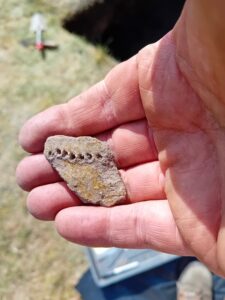We have documentary evidence that there was once a friary somewhere in the vicinity of the Holy Trinity Church, Haddington but no visible traces survive. As part of the ‘East Lothian Archaeology Fortnight’ the Rev. O’Ryan kindly allowed the society to investigate our lost medieval further through a series of test pits in the Rectory lawn. Somewhat fortuitously for us, the layout of Franciscan Friaries tend to be based on a standard model and using a plan from a surviving friary from Ireland, Jon Cooper, HHS member, proposed a likely location for the complex within the current church precinct.

To test Jon’s hypothesis, four 1m x 1m test pits were excavated by our team of professional volunteers from Headland Archaeology, AOC Archaeology and local residents who had all given up their time to help.
Over two days we shifted an awful lot of Victorian/Georgian ‘soil’ (for want of a better word) containing occasional fragments of mortar, tile, glass and coal. These sediments proved to be well over 1m deep across the site and we were not able to bottom out three of the test pits safely. It was, however, possible to do a little more exploratory work on the fourth pit and we came upon layers of compacted, mortar-rich sediments and roughly dressed stone. Much of this was thought to be demolition debris but there is a possibility that some of was in its original position. A piece of what is thought to be 13th-14th century pottery was discovered amongst these lower layers.

So what have we learnt?
1) That there is potential for medieval demolition debris or in situ stonework and floor surfaces to survive in the vicinity of the current rectory. We can’t be certain but there is a strong possibility that these remains are a part of the missing friary.
2) That any further work in the area will require us to work through a significant depth of 18th-19th sediments to reach strata of specific interest.
But hey! that is archaeology for you and why we love it. It will stay as a mystery until some new prospecting technique becomes available to us or the rector allows us into her garden again, this time with a mini-digger and a team of enthusiastic volunteers!! (Don’t worry Rev. O’Ryan, it’s not a serious suggestion – (yet!).

You must be logged in to post a comment.